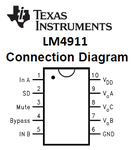Audioguru
Advanced Member level 7

- Joined
- Jan 19, 2008
- Messages
- 9,461
- Helped
- 2,152
- Reputation
- 4,304
- Reaction score
- 2,011
- Trophy points
- 1,393
- Location
- Toronto area of Canada
- Activity points
- 59,764
If you read the datasheet and look at the amplifier schematic for the LM4911 stereo amplifier you will see that it has three amplifiers, not just two.
The third amplifier provides a reference of half the supply voltage for the earphones so that large output coupling capacitors are not needed to block DC.
Any amplifier using a single polarity supply makes a loud POP in the transducer when it is turned on or off. The LM4911 amplifier has a click and pop reduction circuit that needs a capacitor or the controller circuit can do it. I do not know why it has a shutdown mode instead of simply turning it off. Maybe the controller can make it shutdown when you say, "Shutdown!"?
The terrible frequency response of hearing aid balanced armature transducers is made normal with an equalizer that is needed anyway to adjust the response to the deaf person's hearing problem. Some people have frequency notches that must be boosted and other people have frequency peaks that must be reduced. Many people have both. Usually the equalizer in a hearing aid is digital so setting it up is simple and accurate. A hearing aid amplifier circuit also has compression so that very loud sounds have their level reduced to normal and very weak sounds are automatically boosted.
The third amplifier provides a reference of half the supply voltage for the earphones so that large output coupling capacitors are not needed to block DC.
Any amplifier using a single polarity supply makes a loud POP in the transducer when it is turned on or off. The LM4911 amplifier has a click and pop reduction circuit that needs a capacitor or the controller circuit can do it. I do not know why it has a shutdown mode instead of simply turning it off. Maybe the controller can make it shutdown when you say, "Shutdown!"?
The terrible frequency response of hearing aid balanced armature transducers is made normal with an equalizer that is needed anyway to adjust the response to the deaf person's hearing problem. Some people have frequency notches that must be boosted and other people have frequency peaks that must be reduced. Many people have both. Usually the equalizer in a hearing aid is digital so setting it up is simple and accurate. A hearing aid amplifier circuit also has compression so that very loud sounds have their level reduced to normal and very weak sounds are automatically boosted.



